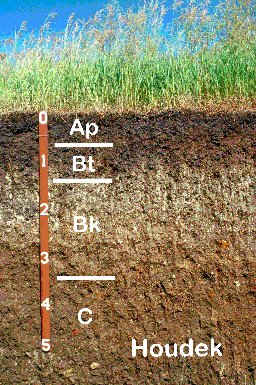|
© Eric R. Pianka  Diagram of typical soil changes along the transitition from prairie (deep black topsoil) to forest (shallow topsoil) at the edge of the North American Great �Plains. [After Crocker (1952). Much of modern soil science, or pedology, was anticipated in the late l800s by the prominent Russian pedologist V. V. Dokuchaev. He devised a theory of soil formation, or pedogenesis, based largely on climate, although he also recognized the importance of time, topography, organisms (especially vegetation), and parent materials (the underlying rocks from which the soil is derived). The relative importance of each of these five major soil-forming factors varies from situation to situation. The above Figure shows how markedly the soil changes along the transition from prairie to forest in the midwestern United States, where the only other conspicuous major variable is vegetation type. Grasses and trees differ substantially both in mineral requirements and in the extent to which the products of their own primary production contribute organic materials to the soil. Typically, natural soils underneath grasslands are considerably deeper and richer in both organic and inorganic nutrients than are the natural soils of forested regions. Over many centuries, as the tall grasses of the North American prairie were burned and decomposed year after year, rich black topsoils were slowly built up. These very productive soils represent a priceless heritage that has been slowly squandered by unappreciative farmers and megacorporations. Nutrient depletion and soil loss by erosion have taken their toll. The ancient deep black topsoils of the prairies made America a 'bread basket' for the world, allowing us to export grains to less fortunate peoples in other parts of the world without access to such amenable climates and rich soils. Sustained agriculture depletes the nutrient pools of soils -- in order to maintain production, soils must be fertilized with nitrogen and phosphorus and other minerals. Animal wastes such as bat and bird guano were used as fertilizers until they began to be depleted. Then, just as such natural fertilizers were running out, the Haber-Bosch process was discovered, which allowed natural gas to be used to turn inert atmospheric nitrogen into ammonia fertilizer. Without this technological breakthrough, human populations would have become limited by food supplies long ago and at much lower population densities. Access to these almost unlimited inexpensive fertilizers has encouraged overuse resulting in massive nitrogen pollution. Soil development from bare rock, or primary succession, is a very slow process that often requires centuries (soil losses due to erosion caused by human activities are serious and long-term). Rock is fragmented by temperature changes, by the action of windblown particles, and in colder regions by the alternate expansion and contraction of water as it freezes and thaws. Chemical reactions, such as the formation of carbonic acid from water and carbon dioxide, may also help to dissolve and break down certain rock types like limestones. Such weathering of rocks releases inorganic nutrients that can be used by plants. Eventually, lichens establish themselves, and as other plants root and grow, root expansion further breaks up the rock into still smaller fragments. As these plants photosynthesize, they convert inorganic materials into organic matter. Such organic material, mixed with inorganic rock fragments, accumulates, and soil is slowly formed. Early in primary succession, production of new  organic material exceeds its consumption and organic matter accumulates; as soil "maturity" is approached, soil eventually ceases to accumulate. Whereas most organic material is contributed to soils from above as leaf and litter fall, mineral inorganic components tend to be added from the underlying rocks below. These polarized processes thus generate fairly distinct layers, termed soil "horizons."
organic material exceeds its consumption and organic matter accumulates; as soil "maturity" is approached, soil eventually ceases to accumulate. Whereas most organic material is contributed to soils from above as leaf and litter fall, mineral inorganic components tend to be added from the underlying rocks below. These polarized processes thus generate fairly distinct layers, termed soil "horizons."
Even though litter fall is high in tropical forests, it does not accumulate to nearly as great an extent as it does in the temperate zones, presumably because decomposition rates are very high in the warm tropics. As a result, tropical soils tend to be poor in nutrients (high rainfall in many tropical areas further depletes these soils by ����leaching out water-soluble nutrients). For both reasons, tropical areas simply cannot support sustained agriculture nearly as well as can temperate regions. In addition, diverse tropical communities are probably more fragile than temperate-zone systems. Links: Erosion Threat -- Vidal Fiona Harvey "Soil Under Strain" Peter Salonius on Forest Soils (pdf) |